 Relevancy and Engagement
maine.agclassroom.org
Relevancy and Engagement
maine.agclassroom.org
FoodMASTER: Grains
Grade Level
Purpose
Students describe the steps of making flour, compare the nutritional value of different cereals, compare cooked and uncooked rice, and identify the parts of a whole grain. Grades 3-5
Estimated Time
Materials Needed
Engage:
- Wheat Stalks for each student (optional)
- Wheat grinder (optional)
Activity 1: Selecting Cereal
- For the teacher: 1 box Wheat Chex®, 1 box Cheerios®, 1 box Frosted Shredded Wheat®, 1 box Frosted Flakes®, 1 box Froot Loops®.
- *Generic equivalents or brand name products may be used.
- For each student: 1 plate.
- Selecting Cereal student handout
- Scientific Inquiry: Label Logic student handout
- Teacher Answer Key
Activity 2: Rice Review
- For the teacher: Double burner hot plate, 1 liquid measuring cup, 1 pot with lid, 1 set dry measuring cups, plastic bowl, food scale, timer or clock, 1 serving spoon, 1 package instant whole grain brown rice (including directions)*.
- Don’t use boil-in-a-bag rice or a rice mix.
- For each student: 1 plate, 1 fork, 1 piece uncooked brown rice.
- While You Wait Activity: Colored Pencils
- Rice Review student handout
- Scientific Inquiry: Nice Rice student handout
- While You Wait: Main Grain student handout
- Teacher Answer Key
Activity 3: Pasta Perfection
- For the teacher: Liquid measuring cup, 1 set measuring spoons, double burner hot plate, 2 large pots, 2 timers, 2 stirring spoon, colander or strainer, hot pad holders, tongs, 1 medium pot, 1 serving spoon, salt, water, 16-ounce box regular pasta*, 16- ounce box whole wheat pasta*, 26-ounce jar pasta sauce.
- Note: you can use rotelle, farfalle or spaghetti.
- For each student: 1 plate, 1 fork.
- Pasta Perfection student handout
- Scientific Inquiry: Cooking Pasta student handout
- While You Wait Activity: 1 regular pasta food label, 1 whole wheat pasta food label for each student.
- While you Wait: Brainy Grains student handout
- Teacher Answer Key
Elaborate
Vocabulary
farfalle: pasta shaped like a bow tie
fiber (dietary): isolated, non-digestible carbohydrates that have beneficial physiological effects in humans
rotelle: pasta shaped like a wagon wheel
staple food: a food that is eaten regularly and is a dominant part of the diet, supplying a major proportion of energy and nutrient needs
whole grain: contains all three edible parts (the endosperm, bran, and germ) in the same proportions as the harvested grain seed before it is processed
Background Agricultural Connections
Introduction to FoodMASTER:
FoodMASTER (Food, Mathematics and Science Teaching Enhancement Resource) is a compilation of programs aimed at using food as a tool to teach mathematics and science. It is our theory that if food is used as a tool to teach mathematics and science, students will be better prepared to demonstrate and apply mathematic and scientific knowledge. Because students encounter food on a daily basis, they have preexisting contextual experiences preparing them for learning new and relevant mathematics and science material.
Food is conducive to hands-on and virtual, inquiry-based, active learning that uses multiple senses to engage students in the learning process. Utilizing food allows for an interdisciplinary approach to learning concepts and ideas in a variety of scientific subjects like general science, biology, chemistry, microbiology, nutrition and health. Additionally, food labs are a dynamic way to teach mathematics concepts such as numbers and operations, algebra, geometry, measurement and problem solving.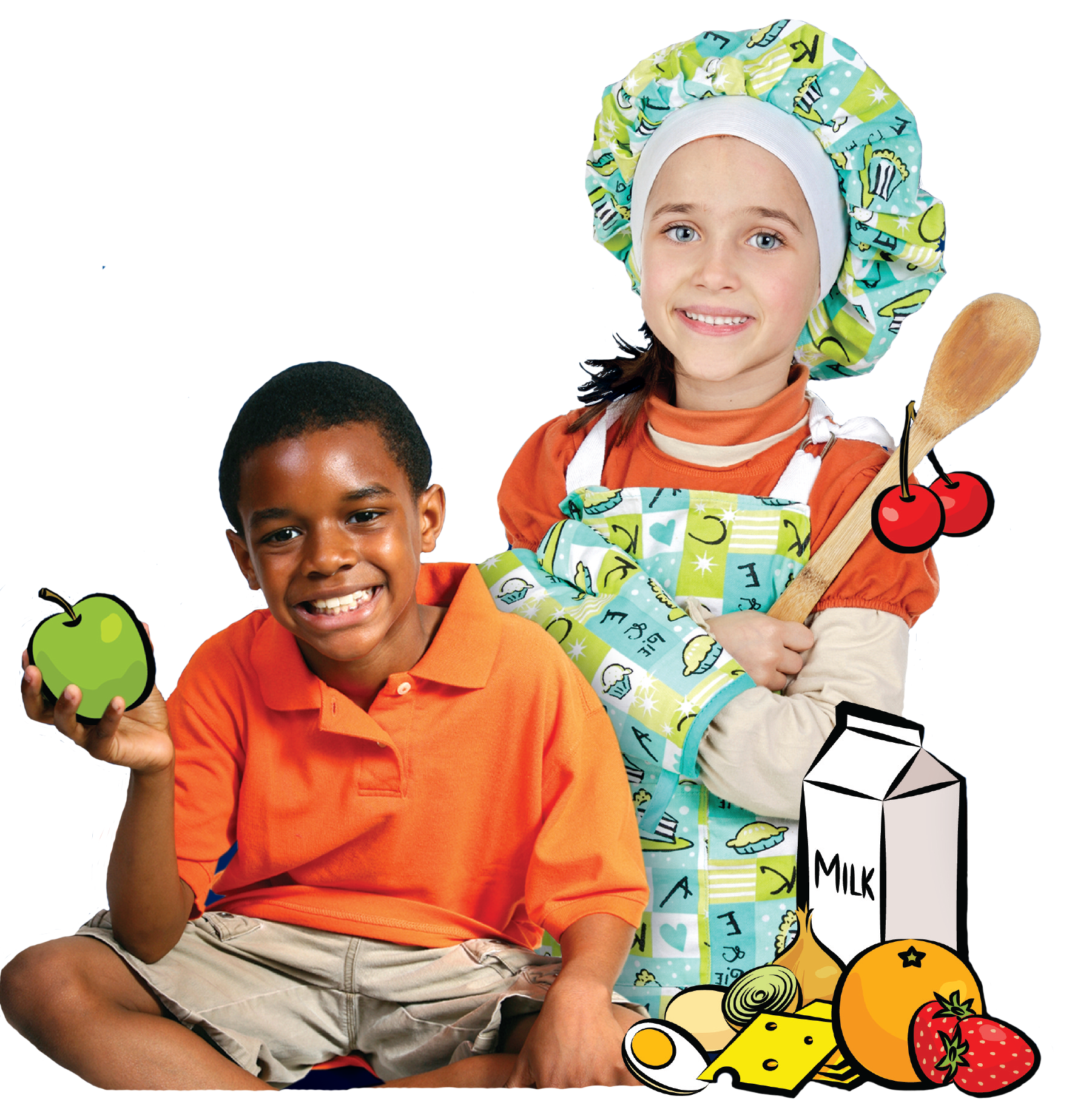
The knowledge and skill development that can be inspired by the FoodMASTER approach is limitless. Proper use of measurement tools, data collection and interpretation, application and generalization, classification and organization, graphing and comparative analysis, understanding chemical changes, observing functions of ingredients and controlling variables, pricing, critical thinking, self-directing learning, and team building are only a few of the potential knowledge and skill development areas for intermediate grade students experiencing FoodMASTER’s scientific inquiry labs.
Additional FoodMASTER lessons can be found to cover health and nutrition topics such as:
- Food Safety
- Vegetables
- Fruits
- Meat, Poultry, and Fish
- Eggs
- Fats and Oils
- Grains
- Measurement
- Meal Management
Background for this Lesson:
Wheat, rice, corn, oats, barley and rye are all grains (plants that belong to a family of grasses). Grains are used to make foods like bread, breakfast cereal, rice and pasta. These products can be made from whole grains or processed grains. Whole grains have three parts called the bran, endosperm and germ. The endosperm contains carbohydrates. The bran and germ are full of vitamins, minerals and fiber. Sadly, the bran and germ are removed from processed grains. Processed grains are left with mostly endosperm. Most Americans need to eat more whole grains.

In this lesson, students will:
- locate calories, grams of fiber and grams of sugar on food labels.
- classify cereals as whole grains or not whole grains, use correct unit labels, and record data in a table.
- order cereals from most to least based on nutrition facts and explain why one cereal is healthier than another.
- learn how to prepare instant brown rice, accurately measure the volume and weight of rice, and record data in a table.
- name and label the three parts of a whole grain and read a graph and draw reasonable conclusions.
- learn how to prepare pasta, name two types of pasta and explain differences between regular and whole wheat pasta.
- locate serving size, servings per container, calories and grams of fiber.
- record data in a table and make reasonable conclusions and use mathematics to solve real life problems. For example, students will use division to calculate the cost of pasta per serving.
Engage
- Ask your students what the primary ingredient is in bread. Once they identify that flour is the main ingredient, ask them what flour is and where it comes from.
- Show students a bundle of wheat and explain that farmers grow wheat. Wheat grows from seeds. Wheat is green while it is growing, then turns a golden yellow color when it is ready to harvest. A machine called a combine cuts the wheat and separates the stem from the head. The stems are usually called "straw" and are used for animal bedding. The heads contain the wheat seeds. A process called, "threshing" removes the seeds from the heads. The seeds are ground up at a mill and made into the flour we use for cooking.

- If possible, show your students a stalk of wheat. Give each student 1 stem and allow them to thresh the wheat. See this tutorial for a demonstration. You may even collect all of their wheat seeds and put them through a wheat grinder to allow them to see the wheat turn into flour. Now that your students know how wheat is grown and processed, they are ready to learn about grains!
Explore and Explain
Activity 1: Selecting Cereal
Scientific Inquiry: Label Logic
- Read Selecting Cereal and complete the Doodle Bugs.
- Review label reading.
- Show the class where to find calories, fiber and sugar on the Nutrition Facts label. Note, fiber and sugar are both types of carbohydrates, so they are found underneath “total carbohydrates” on the food label. Be sure to point out the units of measurement and remind students to record these units.
- Explain that the ingredients are listed from most to least. Remind students that whole grains will have the word “whole” before the grain (whole wheat, whole oats, etc.)
- Divide the class into five groups.
- Give each group a box of cereal. Ask the students to read the food label as a group and complete the correct line of the Cereal Nutrition Facts table.
- Rotate the boxes between groups, until all students have completed the Cereal Nutrition Facts table.
- When the students have completed questions one to three, pass out plates and cereal samples.
-
Students will try a sample of each cereal and then complete questions four and five.
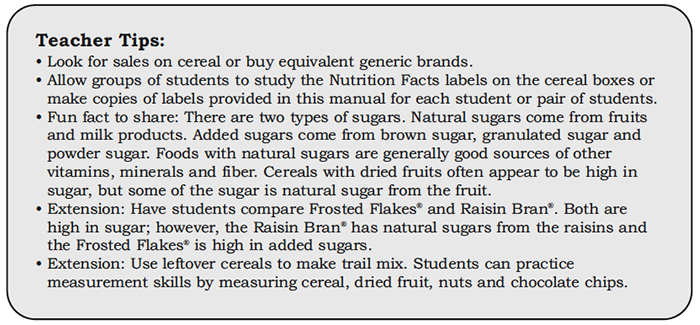

Activity 2: Rice Review
Scientific Inquiry: Nice Rice
- Students will read the directions and measurement table on the rice package label. Then they will complete the Rice Cooking Facts table.
- Place the pot on a double burner. Have students measure and pour one and three fourths cups of water into the pot. Bring water to a boil.
- Next, allow students to measure two cups of rice. Place an empty plastic bowl on the food scale. Zero the scale and allow students to measure the weight of the rice.
- While the water heats, read Rice Review and complete the Doodle Bugs.
- When the water boils, an adult should add the measured rice and follow package directions to prepare the rice. Students will set a timer for cooking time and standing time.
- Students may then work on While You Wait: Main Grain.
- After the rice is done, let it cool slightly. Show students the pan and ask “What happened to the water?” Students will then measure the weight of the cooked rice. To weigh the rice, place the plastic bowl on the scale, zero the scale and then add the rice.
- Give each student a plate, a fork, a piece of uncooked rice and a sample of cooked brown rice. Ask students to compare the pieces of rice, complete the Rice Facts tables, taste the rice and answer any remaining questions.
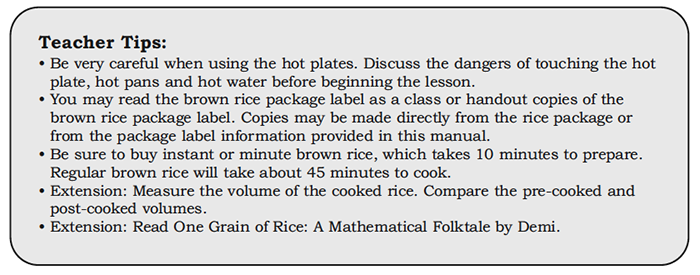
While You Wait: Main Grain
- Instruct students to color the parts of the rice grain and draw a processed grain. Students may turn back to the Chapter Introduction for a review of the three parts.
- Students will then read the graph and answer the questions.
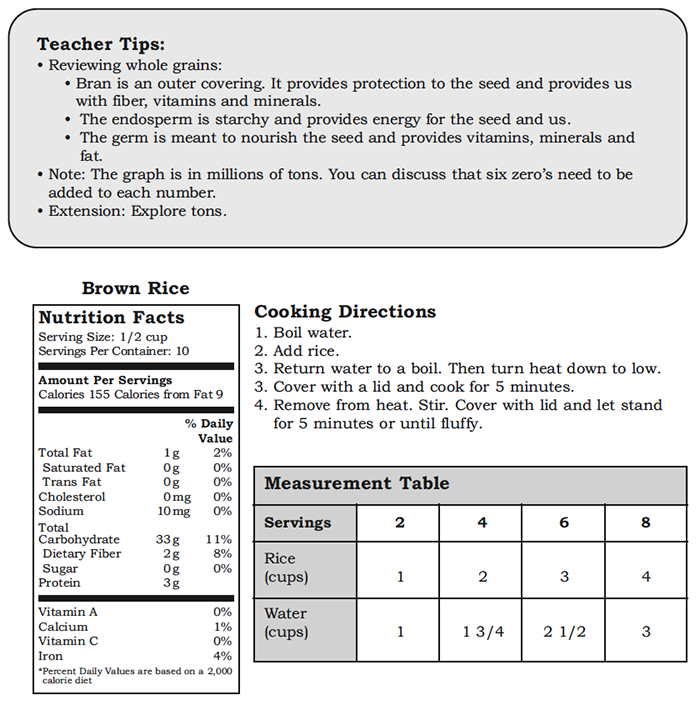
Activity 3: Pasta Perfection
Scientific Inquiry: Cooking Pasta
- Begin by placing your large pots on the double burner hot plate. Add water and bring to a boil.
- Read Pasta Perfection and complete the Doodle Bugs.
- When water boils, an adult should carefully add regular spaghetti to one pot and whole-wheat spaghetti to the second pot. Allow students to set timers for the spaghetti according to package directions.
- Students may complete While You Wait: Brainy Grains while the pasta is cooking.
- If desired, heat pasta sauce in the medium pot.
- When the pasta is done, an adult should use a strainer/colander to drain water from each pot. Be sure to pour away from yourself.
- An adult will then serve a small portion of each type of pasta to each student. As the pasta is being served, asked “Has anyone tried whole wheat pasta before? Can anyone remember the three parts of a whole grain? The one part of a processed grain?” Be sure to ask students how well they like the whole-wheat pasta.
- After tasting the pastas, students will complete the Regular and Whole Wheat Facts table.
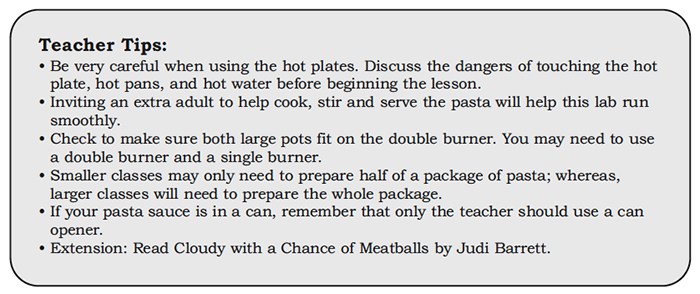
While You Wait: Brainy Grains
- Complete the two practice problems as a class.
- Review where to find the serving size, number of servings per container, calories and fiber on the Nutrition Facts label. Be sure to point out the units of measurement and remind students to record these units.
- Ask students to use the pasta food labels to complete the Pasta Facts table.
- Instruct students to answer questions one to five. Your students will discover that the whole wheat pasta is more expensive. You can point out that eating healthy sometimes is more expensive. Ask your students “Do you think paying a little more to enjoy healthier food is worth it?”
- Students who get done early may try solving the challenge question.
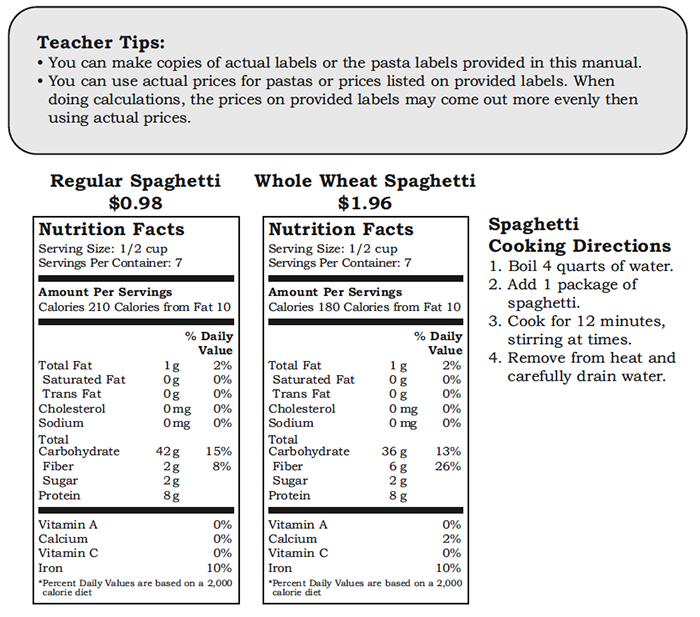
Elaborate
-
Play the My American Farm interactive game Amazing Grains.
-
A-maizing Corn: Complete the math enrichment activity. Students learn about popcorn and what makes it pop.
Evaluate
After conducting these activities, review and summarize the following key concepts:
- Wheat is grown by farmers. After it is harvested it is turned into flour, which is used to make foods such as bread, cereals, and pasta.
- A "whole grain" food is one that uses the entire grain seed (wheat, rice, corn, oats, barley).
- Food processing is changing the original product grown by the farmer (wheat or rice) into the product sold on store shelves. For example grinding wheat into flour or making pasta or cereal.
Acknowledgements
- Created by: FoodMASTER- Food, Math, and Science Teaching Enhancement Resource
- Sponsored by: SEPA- Science Education Partnership Award
- Partnered with: Ohio University and East Carolina University
- Graphics provided by FoodMASTER
Recommended Companion Resources
- America's Heartland: Wheat Episodes
- Bread Comes to Life
- Bread Lab!
- Bread in a Bag
- California Rice: Farming with Nature
- Eat Happy Project Video Series
- Everybody Bakes Bread
- Everybody Cooks Rice
- Food Group Puzzle
- Grains Flowchart
- Grains and Legumes of the World
- Grains on MyPlate
- Hero for the Hungry: The Life and Work of Norman Borlaug
- Let's Get Growing!
- Look Inside Food
- Mama Provi and the Pot of Rice
- My American Farm
- One Grain of Rice
- Pancakes, Pancakes!
- Rice Farming TV
- Sorghum: The Super Grain
- Still There Was Bread
- The Boy Who Changed the World
- The Science of Cooking
- The Tortilla Factory
- The Wheat Doll
- Wheat Bundle
- Wheat Grinder